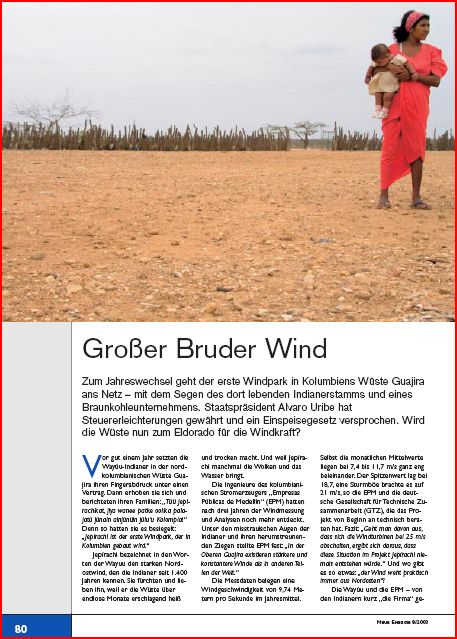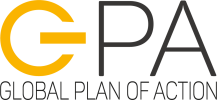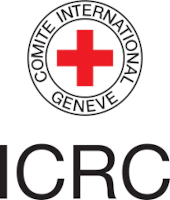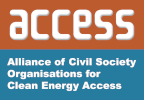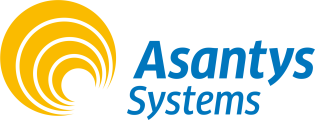Difference between revisions of "Social Assessment - Wind Energy"
***** (***** | *****) |
***** (***** | *****) m |
||
| (29 intermediate revisions by 4 users not shown) | |||
| Line 1: | Line 1: | ||
| − | + | [[Portal:Wind|► Back to Wind Portal]] | |
| + | = Overview - Aspects of Social Assessments<br/> = | ||
| + | |||
| + | Conducting '''social assessments''' has the purpose to evaluate and observe potential impacts of wind energy projects. Besides producing energy and providing for positive economic, social and environmental developments, in particular the windmills can cause un-wanted effects too. | ||
| + | |||
| + | <u>Possibly these are related to:</u> | ||
*noise pollution | *noise pollution | ||
| − | *visual disturbances | + | *visual disturbances |
*well-being and comfort | *well-being and comfort | ||
*socio-economic valuation of land/property. | *socio-economic valuation of land/property. | ||
| + | <br/> | ||
| + | |||
| + | Mentioned negative impacts bear subjective connotations. For instance, the noise pollution might not all be assessed disturbing from a technical point of view; i.e. below noise emission values. However, inhabitants may consider it noisy nevertheless from their subjective point of view. | ||
| + | |||
| + | To circumvent or mitigate any negative effects, it is advisable to conduct ex-ante social (impact) assessments as well as to make the social and cultural aspects a continous observation area in [[Monitoring_and_Evaluation_(M&E)_-_Wind_Energy|monitoring]]. | ||
| + | |||
| + | <br/> | ||
| + | |||
| + | = Target Group / Stakeholder Analysis<br/> = | ||
| + | |||
| + | An important aspect of social assessments is the identification of the target group resp. the persons that are directly and indirectly concerned by the wind energy measure. Thereby, one can differentiate between the '''target group''' and stakeholder. | ||
| + | |||
| + | "The term target groups (beneficiaries) denotes those social groups within whose domain the results of a project are intended to take place.(...) In order for projects/programmes to be successful and sustainable, they must be geared to the desires, wishes, interests, needs and capabilities of the target group. Target groups are therefore fundamentally differentiated by the criteria of gender, social stratification, age and ethnicity."<ref>GTZ 2006: Begriffswelt. http://www.gtz.de/glossar/ p. 38/100. Eschborn</ref> | ||
| + | |||
| + | In comparison to this, '''stakeholder '''exceed the target groups while referring as well to the partners in a project and to "actors who hold at least a potential stake in a project and its change objective are usually termed stakeholders. The actors concerned wish to protect these interests and avoid losing them at all costs. The material resources, social position and knowledge of these stakeholders make them particularly potent, which enables them to wield significant influence over the design, planning and implementation of the project."<ref>GTZ 2008: Capacity WORKS. The Management Model for Sustainable Development. Eschborn, p. 80</ref> | ||
| + | <u>The target group analysis is a methodological approach to establish how the target groups (ultimate beneficiaries, who are<br/>usually heterogeneous):</u> | ||
| + | *perceive their problems, | ||
| + | *to identify the changes they desire and | ||
| + | *to establish their scope of action, in order to facilitate the target-group orientation of the project/programme. | ||
| − | + | <br/> | |
| + | The target group analysis is absolutely essential for assessing the outset situation of a project/programme, though it is by no means confined to the preparation phase. | ||
| + | (For an example on how to conduct a target group analysis, see for instance KfW Nr. 31. [http://www.kfw-entwicklungsbank.de/DE_Home/Service_und_Dokumentation/Online_Bibliothek/PDF-Dokumente_Diskussionsbeitraege/AMD32_neu.pdf Zielgruppen- und Beteiligtenanalyse] in der FZ Januar 2003) | ||
| − | + | <u>A stakeholder analysis assists in:</u> | |
| + | *identifying and visualising the relevant actors and their relationships. | ||
| + | *It allows first conclusions and hypotheses to be formulated concerning the respective influence of the various actors on<br/>the issues at stake in the project, | ||
| + | *and concerning relationships and mutual dependencies. | ||
| + | *the analysis sheds light on alliances and problematic relationships. <ref>Parts of the article are based on: GTZ 2006: Begriffswelt. http://www.gtz.de/glossar/ p. 38/100. Status: September 2006 and: GTZ 2008: Capacity WORKS. The Management Model for Sustainable Development. Eschborn</ref> | ||
| + | [[Social Assessment - Wind Energy#toc|►Go to Top]] | ||
| + | = Socio-economic Aspects<br/> = | ||
| − | + | Wind energy projects automatically bear impacts for the socio-economic conditions as already the construction, for instance, may imply: | |
| + | *the provision of employment opportunities | ||
| + | *and capacity building on one hand; | ||
| + | *or disturbance of farming activities, landscape, | ||
| + | *construction noise and dust on the other hand. | ||
| + | <br/> | ||
| + | During operation, wind energy plants offer another source of income but may also affect property prices due to the locations of windmills. | ||
| − | + | Besides identification of such potential positive and negative impacts, further measures might be necessary to alleviate/prevent/mitigate any negative "costs". One possibility can be sponsorship for social infrastructure projects; designing the windmills with the involvement of concerned target groups; joint site selection. | |
| − | + | '''[http://www.gtz.de/de/dokumente/de-windenergie-kolumbien-bruder-wind-2003.pdf Social aspects of windparks] - Example Colombia (*German*)''' | |
| + | [[File:Großer bruder wind.JPG|frame|center|180px|Figure: Großer Bruder Wind]] | ||
| + | [[Social Assessment - Wind Energy#toc|►Go to Top]] | ||
| − | + | = Tourism Impacts<br/> = | |
| − | + | In particular in areas with tourist attractions, windmills can cause "distrubance" in terms of obstruing the view, interrupting tourist activities etc. The may as well be seen as adding value, however. | |
| − | + | <u>For this purpose, social assessments should further take into account to identify</u>: | |
| + | *any tourism infrastructure | ||
| + | *important sites (also heritage sites!) | ||
| + | *places with regular tourism activity | ||
| + | *stakeholders in the tourism industry. | ||
| − | + | [[Social Assessment - Wind Energy#toc|►Go to Top]] | |
| − | + | = Methods and Instruments<br/> = | |
| − | + | A variety of methods and instruments to conduct social assessments have been developed by development organizations, including | |
| − | + | Deutsche Gesellschaft für Internationale Zusammenarbeit (GIZ). | |
| − | + | <u>Approaches are for instance:</u> | |
| + | *Poverty and Social Impact analysis (PSIA) | ||
| + | *Poverty Impact Assessment (PIA) | ||
| + | *Social Impact Assessment | ||
| − | + | [[Social Assessment - Wind Energy#toc|►Go to Top]] | |
| − | + | The first mentioned approaches clearly put emphasis on assessing impacts that specifically concern poor people. PSIA are implemented in the framework of so called '''PRSP (Poverty Reduction Strategy Papers)'''<ref>cp. e.g. GTZ PRSP. http://www.gtz.de/en/themen/uebergreifende-themen/armut/7166.htm, retrieved 07-2011</ref>. | |
| − | < | + | "Social Impact Assessment also looks at the institutional or societal context of a reform or measure and weighs up its political feasibility, tying in sound analysis and dialogue at all stages. The analysis delivers the facts needed to evaluate reform proposals and outlines potential options; actors from politics, sector institutions and civil society engage in dialogue to negotiate a feasible compromise. This places reforms on a wider basis, giving them a better chance of success." <ref>GIZ 2011: Methods and Instruments.Social Impact Assessment. http://www.gtz.de/de/dokumente/giz2011-en-social-impact-assessment.pdf, p. 1</ref> |
| − | + | For Wind Energy projects "social impact assessments" facilitate the dialogue with social actors; this approach assists to make potential risks and conflicts transparent in order to implement possibly required mitigation measures. | |
| − | + | [[Social Assessment - Wind Energy#toc|►Go to Top]] | |
| − | + | = Further Information = | |
| − | + | *[[Portal:Wind|Wind Portal on energypedia]] | |
| − | + | [[Social Assessment - Wind Energy#toc|►Go to Top]] | |
| − | + | = References = | |
| − | < | + | <references /> |
| + | [[Category:Impacts_Social]] | ||
[[Category:Wind]] | [[Category:Wind]] | ||
Latest revision as of 12:21, 29 August 2014
Overview - Aspects of Social Assessments
Conducting social assessments has the purpose to evaluate and observe potential impacts of wind energy projects. Besides producing energy and providing for positive economic, social and environmental developments, in particular the windmills can cause un-wanted effects too.
Possibly these are related to:
- noise pollution
- visual disturbances
- well-being and comfort
- socio-economic valuation of land/property.
Mentioned negative impacts bear subjective connotations. For instance, the noise pollution might not all be assessed disturbing from a technical point of view; i.e. below noise emission values. However, inhabitants may consider it noisy nevertheless from their subjective point of view.
To circumvent or mitigate any negative effects, it is advisable to conduct ex-ante social (impact) assessments as well as to make the social and cultural aspects a continous observation area in monitoring.
Target Group / Stakeholder Analysis
An important aspect of social assessments is the identification of the target group resp. the persons that are directly and indirectly concerned by the wind energy measure. Thereby, one can differentiate between the target group and stakeholder.
"The term target groups (beneficiaries) denotes those social groups within whose domain the results of a project are intended to take place.(...) In order for projects/programmes to be successful and sustainable, they must be geared to the desires, wishes, interests, needs and capabilities of the target group. Target groups are therefore fundamentally differentiated by the criteria of gender, social stratification, age and ethnicity."[1]
In comparison to this, stakeholder exceed the target groups while referring as well to the partners in a project and to "actors who hold at least a potential stake in a project and its change objective are usually termed stakeholders. The actors concerned wish to protect these interests and avoid losing them at all costs. The material resources, social position and knowledge of these stakeholders make them particularly potent, which enables them to wield significant influence over the design, planning and implementation of the project."[2]
The target group analysis is a methodological approach to establish how the target groups (ultimate beneficiaries, who are
usually heterogeneous):
- perceive their problems,
- to identify the changes they desire and
- to establish their scope of action, in order to facilitate the target-group orientation of the project/programme.
The target group analysis is absolutely essential for assessing the outset situation of a project/programme, though it is by no means confined to the preparation phase.
(For an example on how to conduct a target group analysis, see for instance KfW Nr. 31. Zielgruppen- und Beteiligtenanalyse in der FZ Januar 2003)
A stakeholder analysis assists in:
- identifying and visualising the relevant actors and their relationships.
- It allows first conclusions and hypotheses to be formulated concerning the respective influence of the various actors on
the issues at stake in the project, - and concerning relationships and mutual dependencies.
- the analysis sheds light on alliances and problematic relationships. [3]
Socio-economic Aspects
Wind energy projects automatically bear impacts for the socio-economic conditions as already the construction, for instance, may imply:
- the provision of employment opportunities
- and capacity building on one hand;
- or disturbance of farming activities, landscape,
- construction noise and dust on the other hand.
During operation, wind energy plants offer another source of income but may also affect property prices due to the locations of windmills.
Besides identification of such potential positive and negative impacts, further measures might be necessary to alleviate/prevent/mitigate any negative "costs". One possibility can be sponsorship for social infrastructure projects; designing the windmills with the involvement of concerned target groups; joint site selection.
Social aspects of windparks - Example Colombia (*German*)
Tourism Impacts
In particular in areas with tourist attractions, windmills can cause "distrubance" in terms of obstruing the view, interrupting tourist activities etc. The may as well be seen as adding value, however.
For this purpose, social assessments should further take into account to identify:
- any tourism infrastructure
- important sites (also heritage sites!)
- places with regular tourism activity
- stakeholders in the tourism industry.
Methods and Instruments
A variety of methods and instruments to conduct social assessments have been developed by development organizations, including
Deutsche Gesellschaft für Internationale Zusammenarbeit (GIZ).
Approaches are for instance:
- Poverty and Social Impact analysis (PSIA)
- Poverty Impact Assessment (PIA)
- Social Impact Assessment
The first mentioned approaches clearly put emphasis on assessing impacts that specifically concern poor people. PSIA are implemented in the framework of so called PRSP (Poverty Reduction Strategy Papers)[4].
"Social Impact Assessment also looks at the institutional or societal context of a reform or measure and weighs up its political feasibility, tying in sound analysis and dialogue at all stages. The analysis delivers the facts needed to evaluate reform proposals and outlines potential options; actors from politics, sector institutions and civil society engage in dialogue to negotiate a feasible compromise. This places reforms on a wider basis, giving them a better chance of success." [5]
For Wind Energy projects "social impact assessments" facilitate the dialogue with social actors; this approach assists to make potential risks and conflicts transparent in order to implement possibly required mitigation measures.
Further Information
References
- ↑ GTZ 2006: Begriffswelt. http://www.gtz.de/glossar/ p. 38/100. Eschborn
- ↑ GTZ 2008: Capacity WORKS. The Management Model for Sustainable Development. Eschborn, p. 80
- ↑ Parts of the article are based on: GTZ 2006: Begriffswelt. http://www.gtz.de/glossar/ p. 38/100. Status: September 2006 and: GTZ 2008: Capacity WORKS. The Management Model for Sustainable Development. Eschborn
- ↑ cp. e.g. GTZ PRSP. http://www.gtz.de/en/themen/uebergreifende-themen/armut/7166.htm, retrieved 07-2011
- ↑ GIZ 2011: Methods and Instruments.Social Impact Assessment. http://www.gtz.de/de/dokumente/giz2011-en-social-impact-assessment.pdf, p. 1

